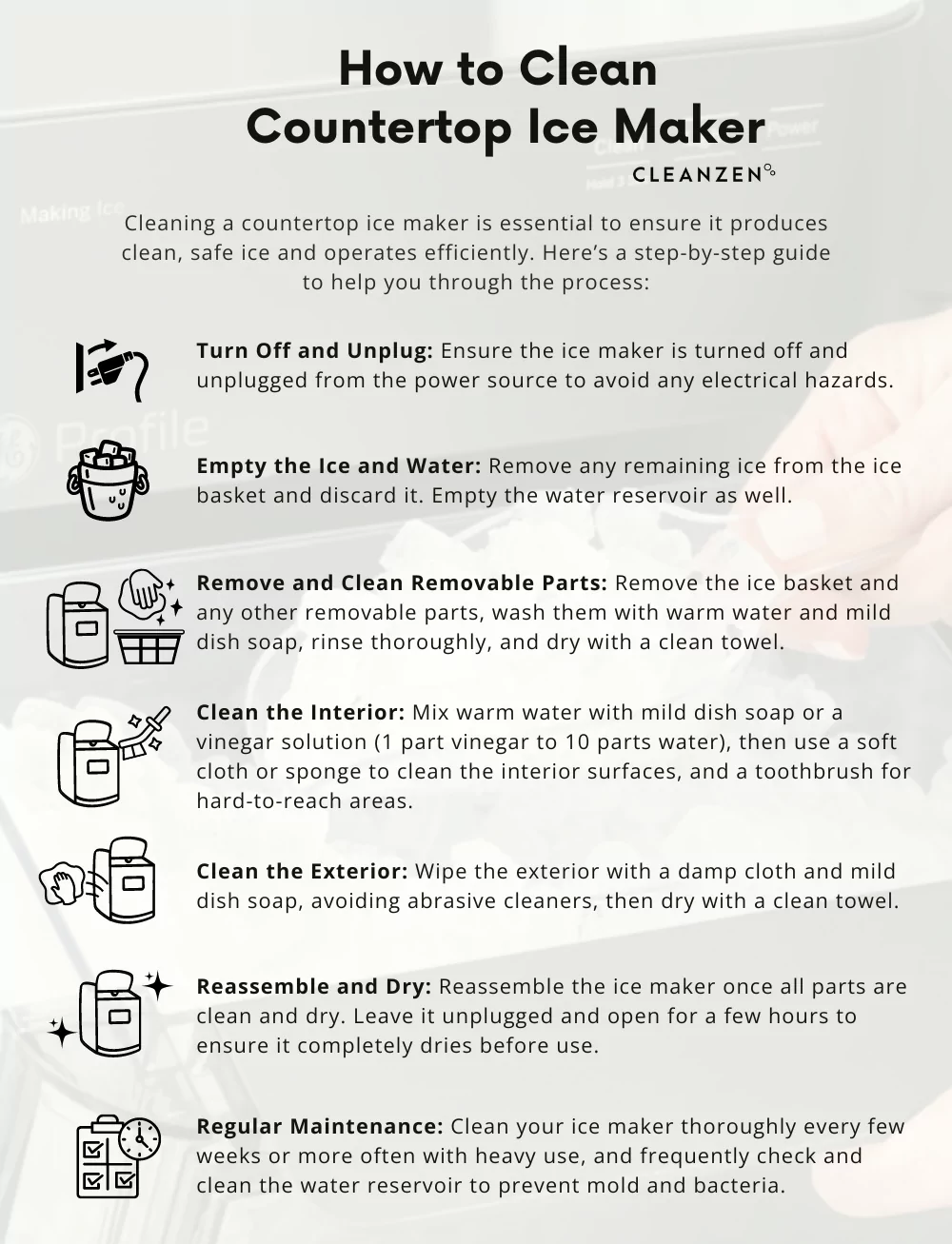How to Clean Ice Maker Parts: A Complete Guide
This post contains affiliate links. As an Amazon Associate, we earn from qualifying purchases.
That first sip of lemonade on a hot day turns sour when your ice cubes taste like freezer burn or look cloudy. Neglected ice makers develop mold in storage bins, mineral scale in water lines, and slime on evaporator plates—ruining ice quality and potentially contaminating your entire refrigerator. Knowing how to clean different ice maker parts properly isn’t just about freshness; it prevents costly repairs and ensures every cube is crystal clear. This guide delivers exact techniques for each component—from the water reservoir to condenser coils—with model-specific steps, chemical ratios, and safety protocols used by appliance technicians. You’ll learn to deep-clean your machine in under 30 minutes while avoiding the #1 mistake that voids warranties.
Power Down Before Touching Any Ice Maker Component
Never skip disconnecting power—this single step prevents 90% of ice maker injuries. Unplug your refrigerator or flip the circuit breaker before accessing any internal parts. The ejector mechanism moves with surprising force during harvest cycles, and water sensors can trigger sudden ice release. For freestanding units, locate the dedicated ice maker shut-off switch behind the machine. Commercial models require locking out the main disconnect per OSHA standards. Critical warning: Wait 15 minutes after power-off before handling the evaporator plate—residual heat can exceed 140°F. After cleaning, always discard the first 3 batches of ice to eliminate chemical residue, even with vinegar solutions.
Exact Cleaning Supplies for Every Ice Maker Part
| Component | Must-Have Supplies | Time-Saver Hack | Disaster to Avoid |
|---|---|---|---|
| Water reservoir | 16oz EPA-approved cleaner (Nyco®) | Use empty cleaner bottle to measure rinse water | Mixing cleaner/sanitizer creates toxic fumes |
| Plastic bins | Dish soap + old toothbrush | Freeze stuck ice with cold water (not heat) | Dishwasher cracks plastic from thermal shock |
| Mold spots | EPA disinfectant spray | Pre-soak grime with vinegar in spray bottle | Undiluted bleach corrodes stainless steel |
| Condenser coils | Fin comb + coil cleaner | Slide unit out completely for full access | Bending fins reduces cooling by 30% |
Pro tip: Keep a dedicated “ice maker kit” in your pantry—small funnel, toothbrush, and microfiber cloth. This eliminates last-minute supply runs when you spot pink slime in your bin.
Ice Storage Bin Deep Clean Process

Removing Your Specific Bin Model
- Side-by-side fridges: Press the release tab inside the bin’s base (often hidden under ice)
- Top-freezer units: Tilt bin backward while lifting upward—no latch required
- French door models: Pull straight out after emptying ice (no tilt needed)
Scrub sequence: Melt stuck cubes with lukewarm water → wash with soapy sponge → dip toothbrush in vinegar for mold corners → rinse until water runs clear → air-dry 20 minutes before reinstalling. Skipping the dry step causes immediate frost buildup, which strains the compressor. For persistent slime, soak the bin in 3 cups vinegar for 10 minutes before scrubbing.
Water Lines & Dispenser Chute Cleaning
Shut off the water supply valve—typically under your sink or behind the fridge—before disconnecting lines. For fridge models, disconnect the 1/4″ tube at the rear inlet valve. Pour 3 cups white vinegar through a funnel into the line, then clamp the tube shut for 8 minutes (set a timer!). This dissolves mineral deposits without damaging seals. Flush with 4 cups cold water to remove vinegar residue. Wipe the external chute flap with a vinegar-dampened cloth, focusing on the rubber seal where frost accumulates. Dry thoroughly with a paper towel—any moisture here causes instant frost when the machine restarts.
Reservoir & Water Pan Descaling

For freestanding units and fridge ice makers with accessible reservoirs: Remove the drain plug beneath the water pan. Let all water drain completely, then pour 16oz of EPA-approved cleaner directly into the pan. Refill the empty cleaner bottle twice with cold water and add that to the pan. Press the CLEAN cycle button—watch for the blinking indicator light. When it turns solid (usually 15-20 minutes), open the drain again to evacuate solution. Tighten the drain plug firmly with pliers; loose caps cause leaks during the next freeze cycle. Skip this step for sealed reservoirs in modern fridge ice makers—vinegar through the water line suffices.
Commercial Evaporator Plate Scale Removal
Turn off the unit and let existing ice melt naturally (don’t chip it!). Remove access panels to expose the evaporator plate. Start the CLEAN cycle, then add diluted cleaner directly to the water trough as it flows over the plate. For severe scaling, remove the water distribution tube and ice thickness sensor—soak both in cleaner for 25 minutes. Scrub the evaporator plate with a soft nylon brush using parallel strokes only (cross-scrubbing damages fins). Rinse all parts under running water until odor-free. Run a SANITIZE cycle with no-rinse food-safe sanitizer—never wipe this off; air-drying activates its antimicrobial properties.
Water Filter & Condenser Coil Care
Replace filters every 6 months—even if ice production seems normal. A clogged filter causes slow harvest cycles and mineral buildup. Install the new filter during cleaning to reset your maintenance calendar. After replacement, run 3 full ice cycles and discard them to flush carbon fines. For condenser coils: Power down the unit, pull it away from the wall, and slide out the air filter. Rinse the filter under warm water, then air-dry completely. Spray coils with cleaner, then gently brush parallel to the fins using a fin comb. Never use vacuum cleaners—they bend delicate fins and reduce cooling efficiency by 25%.
Emergency Mold & Scale Cleanup Protocol
Killing Mold in 15 Minutes
Identify contamination: Pink slime = yeast from bakeries; black spots = toxic mold; musty odor = bacterial growth. Power off the unit, remove all bins, and discard every ice cube. Spray EPA disinfectant on all surfaces, letting it sit for 5 minutes. Scrub moldy crevices with a vinegar-soaked toothbrush, then rinse until no chemical smell remains. For commercial units, run an ozone generator overnight after cleaning to prevent regrowth.
Removing Hard Water Scale
Symptoms: White chalky deposits on cubes, ice sticking to the evaporator, reduced cube size. Soak scaled parts in citric acid solution (1oz per quart of water) for 30 minutes—vinegar won’t cut heavy limescale. For fridge ice makers with sealed reservoirs, run two consecutive vinegar cycles (3 cups each) with a 10-minute soak between. Always follow descaling with a sanitize cycle to neutralize acidic residue.
Post-Cleaning Restart Checklist
- Reinstall all components—tug gently on bins to confirm secure seating
- Restore power and monitor the first harvest cycle for leaks
- Discard first 3 ice batches (commercial units need 5+ batches)
- Test ice quality: Hold a cube against light—cloudiness means repeat rinse cycles
- Wipe exterior surfaces with vinegar solution to prevent future mold
Maintenance Schedule That Prevents 95% of Issues
| Component | Home Units | Commercial Units |
|---|---|---|
| Ice bin wipe-down | Monthly | Weekly |
| Full descale/sanitize | Every 6 months | Every 6 months |
| Water filter | Every 6 months | Every 6 months |
| Condenser coils | Every 6 months | Every 3 months |
| Mold inspection | During cleaning | Every 3 days |
Critical reminder: Mark your calendar for filter changes—most homeowners forget until ice tastes bad, by which point scale has already damaged the reservoir.
Troubleshooting Common Post-Cleaning Issues
Cloudy ice after cleaning: Residual cleaner in water lines. Run 2 extra rinse cycles with cold water only—no vinegar. If persistent, replace the water filter immediately.
Slow ice harvest: Scale still clinging to evaporator. Repeat descaling with extended 45-minute soak time for scaled parts.
Frost on dispenser chute: Moisture trapped in the flap seal. Use a hair dryer on cool setting for 30 seconds before restarting.
Musty odor in ice: Food spills in freezer compartment. Clean freezer shelves with baking soda solution and store food in airtight containers.
Mastering how to clean different ice maker parts transforms your appliance from a contamination risk into a source of pristine, great-tasting ice. By dedicating just 30 minutes every six months to targeted cleaning—and following these model-specific protocols—you’ll extend your machine’s lifespan by 3+ years while ensuring every drink starts perfectly. Keep your ice maker kit stocked, set phone reminders for maintenance dates, and never pour a cloudy drink again.
